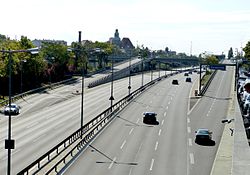Federal Motorway 103
| Bundesautobahn 103 in Germany | ||||||||||||||||||||||||||||

|
||||||||||||||||||||||||||||
| Basic data | ||||||||||||||||||||||||||||
| Operator: |
|
|||||||||||||||||||||||||||
| Start of the street: |
Berlin Sachsendamm ( 52 ° 29 ′ N , 13 ° 21 ′ E ) |
|||||||||||||||||||||||||||
| End of street: |
Berlin Schloßstraße ( 52 ° 27 ′ N , 13 ° 19 ′ E ) |
|||||||||||||||||||||||||||
| Overall length: | 3.5 km | |||||||||||||||||||||||||||
|
State : |
||||||||||||||||||||||||||||
| The A 103 in Berlin-Steglitz , looking south. | ||||||||||||||||||||||||||||
|
Course of the road
|
||||||||||||||||||||||||||||
The Bundesautobahn 103 (abbreviation: BAB 103 ) - short form: Autobahn 103 (abbreviation: A 103 ) - connects the Berlin city ring (A 100) from Kreuz Schöneberg with the Steglitzer roundabout and is a purely urban motorway .
The full length of the A 103 takes on Bundesstraße 1 , which until the beginning of the 1970s led over the parallel historic street of Hauptstraße - Rheinstraße - Schloßstraße . To relieve the districts of Friedenau and Steglitz from heavy traffic , it was swiveled onto the A 103.
Planning
The A 103 was part of the planning for the western bypass . According to the land use plan (FNP) of 1965 for West Berlin , the north , south , east and west bypasses to be created should each touch the historical center of Berlin , which can be interpreted as a geographical circular figure . Here, the A 103 would have been built to the north beyond the motorway stump at the Sachsendamm junction . The planned route would have led the motorway through the Tiergarten Spreebogen tunnel (TTS) or the relief road to the motorway junction at Lehrter Stadtbahnhof , where a connection to the A 107 was to be established. A little further north at the Amrumer Straße junction, the A 103 would have merged into the A 105 . There would also have been a link to the A 100 . The Amrumer Straße underground station contains preliminary structural work. In large parts of the station the ceiling is lower because a motorway tunnel has been prepared above. A cross with the formerly planned A 106 was planned on Tempelhofer Ufer .
The plans for the western bypass were the target of public protests from the start. The " Bürgerinitiative Westtangente", which is still active in urban planning, was established in 1974 after the traffic planners had withdrawn from the priority realization of the A 106 after strong protests from Kreuzberg and Neukölln citizens. In the 1990s, the then Berlin Senate finally ended the plan and sections of the inner-city autobahn that had already been built were downgraded to pure feeder roads, including the appropriate end of the A 105 to connect to the A 111 in the direction of Hamburg , which was originally intended to form the northern part of the western bypass .
From 1975 until German reunification , the autobahn was called "A 13".
Planned dismantling
The district council meeting of the Tempelhof-Schöneberg district voted on May 15, 2019 by a majority in favor of dismantling the route. The six-lane road could therefore become a four-lane. The advance is justified, among other things, with the low capacity utilization. On average, fewer than 30,000 vehicles would be counted per day.
particularities
With the opening of the A 103, several bulges for BVG bus stops were built on the edge of the autobahn as well as on the city ring in order to compete with the operation of bus route 84 of the Wannseebahn (an S-Bahn route) operated by the Deutsche Reichsbahn . The stops were at the following points:
- AS Saarstrasse,
- AS Filandastraße and at
- Albrechtstrasse ( Steglitz Town Hall ).
After the takeover of the S-Bahn in West Berlin by the BVG and the restart of the Wannseebahn as line S1 on May 1, 1985, bus traffic on the 103 urban motorway was discontinued, the stops were abandoned and partially dismantled. They were accessible from the corresponding streets via stairs or short pedestrian tunnels. A stairwell on Albrechtstrasse is now used as an art gallery.
The western staircase at Joachim-Tiburtius-Brücke (AS Filandastraße ) is used as access to Düppelstraße for the sidewalk coming from Filandastraße.
See also
Web links
- Detailed route description of the federal highway 103
- History and pictures of the A 103
- Citizens' initiative Westtangente
Individual evidence
- ↑ Tempelhof-Schöneberg votes to dismantle the A 103. Accessed on May 16, 2019 .



